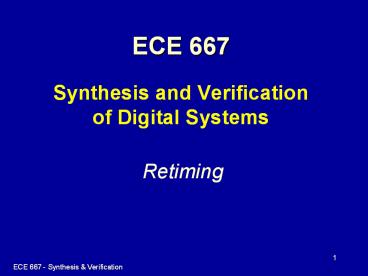ECE 667 Synthesis and Verification of Digital Systems PowerPoint PPT Presentation
Title: ECE 667 Synthesis and Verification of Digital Systems
1
ECE 667Synthesis and Verificationof Digital
Systems
- Retiming
2
Retiming
- Outline
- Problem
- sequential synthesis
- Formulation
- Retiming algorithm
3
Optimizing Sequential Circuits by Retiming
Gate-level Netlist
- Netlist of gates and registers
- Various Goals
- Reduce clock cycle time
- Reduce area
- Reduce number of latches (registers)
Inputs
Outputs
4
Retiming
- Problem
- Pure combinational optimization can be myopic
since relations across register boundaries are
disregarded - Solutions
- Retiming Move register(s) so that
- clock cycle decreases, or number of registers
decreases and - input-output behavior is preserved
- Peripheral retiming Combine retiming with
combinational optimization techniques - move latches out of the way temporarily
- optimize larger blocks of combinational logic
5
Circuit Representation
- Leiserson, Rose and Saxe (1983)
- Circuit representation G(V,E,d,w)
- V ? set of gates
- E ? set of wires
- d(v) delay of gate/vertex v, (d(v)?0)
- w(e) number of registers on edge e, (w(e)?0)
6
Circuit Representation
Example Correlator
0
Host
0
0
0
?
?
2
3
3
0
?(x, y) 1 if xy 0 otherwise
Graph (Directed)
a
b
Circuit
Every cycle in the graph has at least one
register, i.e., there are no combinational loops.
7
Preliminaries
For a path p Clock cycle c
For the correlator circuit c 13 Can we
reduce it to 7 ? How ?
8
Basic Operation
- Movement of registers
- from input to output of a gate or vice versa
- Does not affect gate functionalities
- A mathematical definition retardation
- r V ? Z, an integer vertex labeling
- wr(e) w(e) r(v) - r(u) for edge e (u,v)
Retime by -1
Retime by 1
9
Basic Operation
In the example, r(u) -1, r(v) -1 results
in
0
- For a path p s ? t, wr(p) w(p) r(t) - r(s)
- Retardation
- r V?Z, an integer vertex labeling
- wr(e) w(e) r(v) - r(u) for edge e (u,v)
- A retiming r is legal if wr(e) ? 0, ?e?E (prove
it !)
10
Retiming for Minimum Clock Cycle
- Problem Statement (minimum cycle time)
- Given G (V, E, d, w), find a legal retiming r
so that is minimized - Retiming 2 important matrices
- Register weight matrix
- Delay matrix
11
Retiming for Minimum Clock Cycle
W register path weight matrix (minimum
latches on all paths between u and v) D path
delay matrix (maximum delay on all paths
between u and v)
Delays exceeding 7 shown in red
c ? ? ? ?p, if d(p) ? ? then w(p) ? 1
12
Conditions for Legal Retiming
- Assume that we are asked to check if a retiming
exists for a clock cycle ? - Legal retiming wr(e) ? 0 for all e. Hence
wr(e) w(e) r(v) - r(u) ? 0 or r (u) - r
(v) ? w (e) - For all paths p u ? v such that d(p) ? ?, we
require wr(p) ? 1 - Thus
Or take the least w(p) (tightest constraint)
r(u)-r(v) ? W(u,v)-1 Note this is independent of
the path from u to v, so we just need to apply it
to u, v such that D(u,v) ? ?
13
Solving the Constraints
- All constraints in difference-of-2-variable form
- Related to longest/shortest path problem
Correlator ? 7
Legal r(u)-r(v)?w(e)
14
Solving the Constraints
- Do shortest path on constraint graph (O(V3 )).
- A solution exists if and only if there exists no
negative weighted cycle.
Legal r(u)-r(v)?w(e)
Timing Dgt7 r(u)-r(v)?W(u,v)-1
A solution r(v0) r(v3) 0, r(v1) r(v2)
-1
15
Retiming
To find the minimum cycle time, do a binary
search among the entries of the D matrix (0(?V?3
log?V?))
v0
Retimed correlator
Retime
16
Retiming two more Algorithms
- 1. Relaxation based
- Repeatedly find critical path
- retime vertex at end of path by 1
(O(?V??E?log?V?)) - 2. Also, Mixed Integer Linear Program formulation
1
v
Critical path
u
17
Relaxation Algorithm - Rationale
18
Relaxation Algorithm
19
Relaxation Algorithm step 1
Retime for ? 13
20
Relaxation Algorithm step 2
Retime for ? 13
21
Relaxation Algorithm step 3
Retimed for ? 13
22
Relaxation Algorithm summary(Retiming for ?
13)
23
Retiming for Minimum Area(Minimum Latches)
Goal minimize the number of registers used
where av is a constant for each node v.
24
Minimum Registers - Formulation
- Minimize
Subject to wr(e) w(e) r(v) - r(u) ? 0
- Reducible to a flow problem

